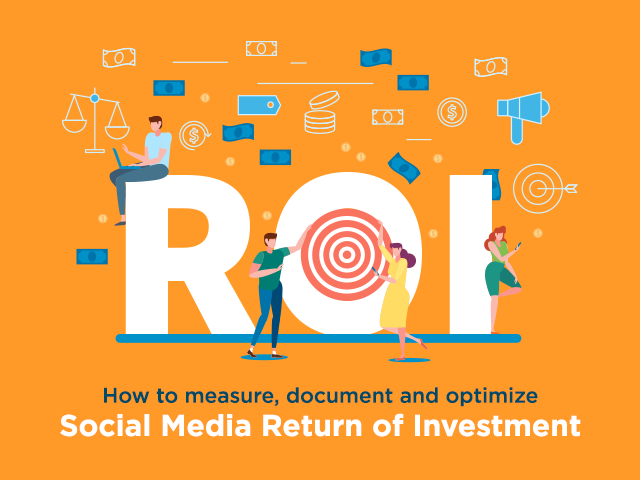
Measuring the Return on Investment (ROI) of social media marketing involves evaluating the effectiveness of social media activities in generating value for the business relative to the resources (time, money, effort) invested. ROI can be both quantitative (financial returns) and qualitative (brand awareness, engagement, etc.). Here’s a structured approach to measuring ROI for social media marketing:
1. Define Your Goals and Metrics
Before you can measure ROI, you need to establish clear, measurable goals that align with your business objectives. These goals could include:
- Brand Awareness: Growing your audience or impressions.
- Lead Generation: Collecting email sign-ups, inquiries, or downloads.
- Conversions and Sales: Actual product/service purchases.
- Customer Engagement: Likes, shares, comments, and interactions.
- Customer Retention: Repeat purchases, loyalty, or customer service metrics.
Each of these goals will have different key performance indicators (KPIs) to track, such as:
- Impressions, reach, and follower growth (for brand awareness)
- Click-through rate (CTR), lead form submissions (for lead generation)
- Conversion rate, revenue, or average order value (for sales)
2. Track Costs (Investment)
Measure the total cost of your social media efforts. This should include:
- Advertising Spend: Costs for paid campaigns like Facebook ads, Instagram ads, LinkedIn promotions, etc.
- Tools and Software: Costs for scheduling tools (e.g., Hootsuite, Buffer), analytics platforms (e.g., Sprout Social), or content creation tools.
- Labor Costs: Time spent by your team on content creation, community management, and strategy development (this can be estimated based on hourly wages or salaries).
Total costs = Advertising Spend + Tools and Software + Labor Costs
3. Measure the Return (Results)
Now, you need to measure the results your social media efforts generate. These are the returns on your investment:
- Revenue: Track sales that are directly attributable to social media efforts. Use tracking links, promo codes, or Google Analytics to connect purchases with social media traffic.
- Leads: If your goal is lead generation, measure the number of leads generated through social media (email sign-ups, form submissions, webinar registrations, etc.).
- Engagement and Brand Value: For goals like brand awareness or engagement, assess the qualitative returns like increased brand sentiment, higher engagement rates (likes, shares, comments), and overall growth in social followers.
4. Calculate ROI
Once you have your costs and returns, you can calculate ROI using the following formula:
ROI=Revenue or Value from Social Media−Total CostsTotal Costs×100\text{ROI} = \frac{\text{Revenue or Value from Social Media} – \text{Total Costs}}{\text{Total Costs}} \times 100ROI=Total CostsRevenue or Value from Social Media−Total Costs×100For example:
- If you spent $5,000 on social media marketing and generated $15,000 in sales, the ROI would be:
ROI=15,000−5,0005,000×100=200%\text{ROI} = \frac{15,000 – 5,000}{5,000} \times 100 = 200\%ROI=5,00015,000−5,000×100=200%This means for every $1 spent on social media, the return was $2.
5. Attribution and Tools
Attribution is key to ensuring you’re correctly connecting the dots between your social media efforts and results. Common methods include:
- First-touch attribution: Giving credit to the first interaction a customer has with your brand.
- Last-touch attribution: Giving credit to the last interaction before conversion.
- Multi-touch attribution: Distributing credit across multiple touchpoints.
Tools like Google Analytics, Facebook Ads Manager, or CRM systems can help track and attribute conversions accurately to social media campaigns.
6. Analyze Qualitative Benefits
While ROI calculations are typically quantitative, it’s important not to overlook qualitative aspects:
- Brand Awareness: Track improvements in search volume or social mentions.
- Customer Loyalty: Monitor repeat customers and community-building efforts.
- Customer Sentiment: Conduct surveys or track social media sentiment to see how your brand perception changes.
7. Adjust and Optimize
Regularly assess the ROI and adjust your strategies based on insights. If certain platforms or content types are yielding higher returns, focus your resources on those areas.
Example:
Let’s say a brand runs a campaign on Instagram:
- Investment: $10,000 in ad spend and labor.
- Return: $25,000 in sales generated through Instagram (tracked with unique links and discount codes).
Then the ROI calculation is:
ROI=25,000−10,00010,000×100=150%\text{ROI} = \frac{25,000 – 10,000}{10,000} \times 100 = 150\%ROI=10,00025,000−10,000×100=150%This means the campaign generated 150% more revenue than the costs incurred.
In summary, measuring ROI for social media marketing involves tracking both the costs (time, money, tools) and the returns (sales, leads, engagement) and then applying the ROI formula. It’s also important to account for both direct financial outcomes and long-term brand building that might not immediately show up in revenue but still contribute to the business’s growth.